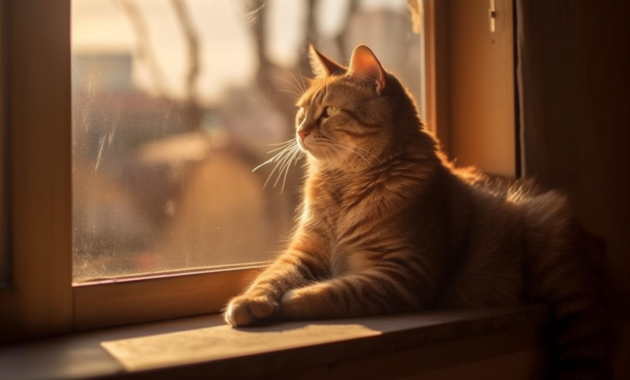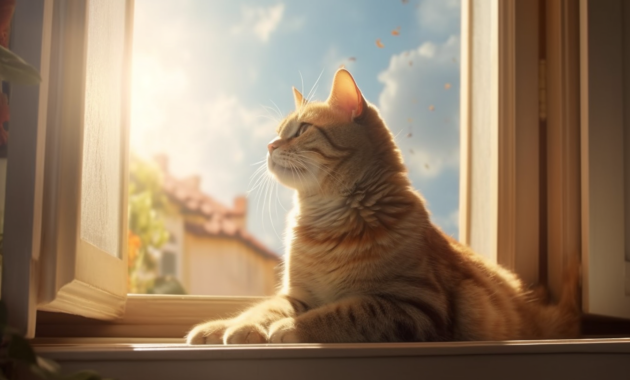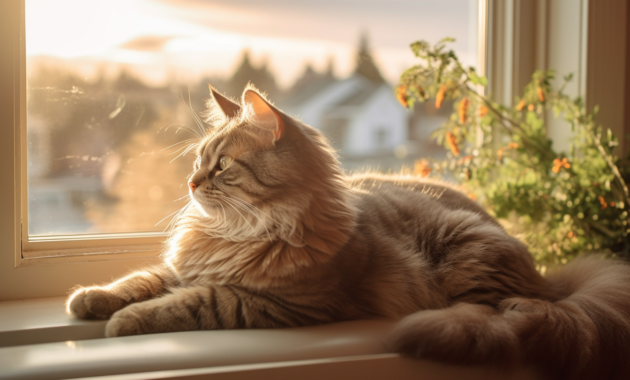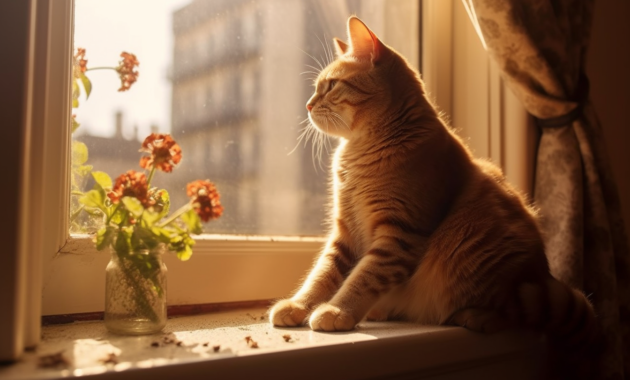
Cats are often considered solitary creatures, content to spend their days alone and out of sight.
But contrary to popular belief, cats can form strong emotional bonds with their owners.
Cats that are happy being alone can be some of the most loyal and loving companions in the world!
As a cat behaviour expert, I’m here to show you how to ensure your independent feline gets the love and attention it needs for a healthy, fulfilling life.
The key to having a happy cat that doesn’t need constant companionship is understanding its individual needs.
Every cat is unique, so you’ll need to take the time to get to know your pet’s personality and preferences.
With a little effort and patience, you can give your cat all the love it needs while respecting its desire for independence.
Recognizing Your Cat’s Unique Temperament

Regarding cats and their temperaments, one size does not fit all.
Some cats are content to be left alone for long periods, while others may become anxious or distressed.
Recognizing your cat’s unique needs is vital in creating boundaries and building trust.
Please take a moment to observe your cat’s behaviour when they’re given freedom and independence.
Are they content with having their own space, or do they quickly seek out interaction and attention from you?
A cat that finds joy in being alone will enjoy exploring their environment on its terms, often curling up for naps in cozy corners away from the hustle and bustle of family life.
On the other hand, cats that prefer company may grow restless if left alone for too long – always looking for a new person or animal to interact with.
It is essential to respect a cat’s need for solitude as much as any need for companionship.
Establishing a balance between giving them appropriate alone time and providing plenty of socialization opportunities can help build trust between you and your pet.
After all, every cat deserves love – whether independent or shared with another!
SEE ALSO
Cats That Are Good With Families
Cats That Are Good With Seniors
Providing Mental Stimulation

Cats happy alone still need mental stimulation to lead a healthy life. Creating routines can help keep cats mentally engaged and give them some form of structure in their daily lives.
Encouraging exploration inside and outside the home is also essential when possible.
To aid in providing mental stimulation for lone cats, we suggest the following activities:
| Activity | Description |
|---|---|
| Puzzle Feeders | For cats who enjoy watching wildlife or looking outside, placing a bird feeder near a window or balcony may provide hours of this activity, allowing them to watch from the comfort of their own space, stimulating their curiosity and encouraging exploration. |
| Interactive Toys | For cats who enjoy watching wildlife or looking outside, placing a bird feeder near a window or balcony may provide hours of this activity, allowing a cat to watch from the comfort of their own space, stimulating their curiosity and encouraging exploration. |
| Window Watching/ Bird Feeder Viewing | Interactive toys, such as those that respond to motion or sound, will give your cat something exciting to focus on throughout the day. This can help keep them active and alert while alone at home without any other felines around. |
These activities can be beneficial not only for providing mental stimulation but also for physical exercise as well.
They can help keep cats content and satisfy their need for play and curiosity, even if they prefer spending time alone.
Ensuring Physical Activity

Providing mental stimulation for cats who prefer to be alone is only half the equation.
Cats also need regular physical activity to stay healthy and content.
Ensuring your solitary cat gets plenty of exercise can be challenging, but with some creativity, you can help them stay active and alert.
First and foremost, creating structure is vital for getting your independent feline friend up and moving.
Schedule regular playtimes throughout the day, just as you would if you had multiple cats.
This will help keep their minds sharp and encourage them to avoid bad habits like excessive sleeping or lounging all day.
Additionally, provide plenty of toys for your pet to explore independently.
Interactive puzzles can encourage problem-solving, while feather wands and scratching posts can help them release some pent-up energy.
Regarding it, encouraging playtime with your solo kitty is essential for keeping them mentally stimulated and physically fit!
Spend quality time playing together every day, even just for a few minutes at a time.
Ensure you engage with them by using toys that mimic hunting behaviour, such as laser pointers or toy mice tied onto strings or sticks.
Not only will this give your cat a sense of purpose, but it will also bring you closer together – a bonus side effect! Ultimately, ensuring that your lone cat gets enough physical activity is essential to keeping both of you happy and healthy -no matter how much space they need from time to time!
Meeting Social Needs
Cats happy alone can still benefit from social interaction with their human companions.
Creating space and respecting boundaries are essential when interacting with a solitary cat.
These cats may not be as open to physical contact.
However, they will still appreciate verbal communication, such as speaking calmly and soothingly or providing mental stimulation through play.
Cats that prefer solitude should not be forced into social interactions with humans or other animals, as this can lead to stress and potentially push them further away from the desired relationship.
Instead, allowing solitary cats to take the lead is essential when determining how much human contact they want.
This could look like whispering and offering rewards for behaviours that are desirable in the context of your relationship.
Providing these cats access to windows and other areas where they can watch birds and observe their surroundings can help meet their natural curiosity while respecting their preference for distance.
Additionally, providing them with hiding spots around the house allows them to retreat if they feel overwhelmed during interactions.
Allowing a cat its own space and getting creative about ways to interact can go a long way in creating a bond between them and its human companions.
Understanding The Benefits Of Solo Living
While cats are often considered independent and aloof creatures, they still have social needs that must be met.
Understanding the benefits of solo living can help cats that enjoy being alone to thrive and lead happy lives.
One of the main advantages of solo living for cats is that it eliminates stress from competing with other animals for food, attention, or bonding rituals.
Without the competition for resources, cats can focus on their own needs and activities without feeling overwhelmed by other animals.
Additionally, solitary cats are less likely to become victims of bullying or territorial disputes between other animals in the household.
Cats who live alone also benefit from being able to establish a routine that meets their individual needs.
They may take more time grooming themselves or exploring their environment at their own pace.
This allows them to develop strong bonds with their owners as they tackle loneliness and make meaningful connections through shared experiences such as playtime or cuddling sessions.
By taking advantage of these bonding opportunities, solo-living cats can experience the same connection and satisfaction as those living in multi-cat households.
Frequently Asked Questions
How Can I Tell If My Cat Is Happy When It Is Alone?
They are puzzled by how to tell if your cat is content when alone?
Feline behaviour experts suggest observing their solitary behaviour and providing stimulation to meet their physical and mental needs.
It is important to note that cats differ in personalities and can enjoy both social and solitary environments.
To determine whether or not your cat is happy being alone, look for signs such as purring, relaxed posture, or grooming themselves while alone.
Additionally, providing them with feline enrichment activities such as puzzle feeders or interactive toys can help keep them content when left alone.
Ultimately, cats that are happy being alone will exhibit behaviours that show they feel secure and safe even when not in the company of others.
Are There Any Risks Associated With Cats Living Alone?
Yes, there are risks associated with cats living alone.
Cats can become fearful or aggressive towards people and animals without regular socialization, making them difficult to handle and potentially a safety risk.
To help prevent this, cat owners should provide environmental enrichment, such as interactive toys that encourage play and exploration.
Additionally, having more than one cat in the home can help cats stay socially engaged and emotionally fulfilled alone.
If you own a solitary cat, spending quality time with them daily is essential to ensure they remain happy and healthy.
Can I Introduce A New Cat To My Cat, That Is Used To Living Alone?
Introducing a new cat to your existing cat that is used to living alone can be an exciting experience for both cats.
As a cat behaviour expert, I recommend taking the process slowly and giving each of them time to get used to the other’s presence.
Start by socializing the cats in separate rooms and gradually increasing their interactions.
Make sure to provide plenty of space for both cats and ensure they have access to their own food and litter boxes.
With patience and understanding, you can ensure a safe, happy environment for both cats while helping them build a strong bond with one another.
How Do I Know If My Cat Is Getting Enough Exercise When Living Alone?
It pays to think outside the box when you ensure your cat is getting enough exercise while living alone.
Boredom can be a significant issue for cats who don’t have playmates, but with a bit of creativity and cat enrichment, you can help keep them physically and mentally active.
Spending time with your cat daily, playing games that challenge their problem-solving skills or providing them with interactive toys will help keep them engaged and entertained.
If you’re looking for an extra challenge, try setting up an obstacle course or hide-and-seek game.
Your lonesome kitty will live life to the fullest with effort and dedication!
What Is The Best Way To Provide Mental Stimulation For A Cat That Lives Alone?
Providing mental stimulation for a solo cat is essential, and there are several ways to do it.
Cat toys that require your cat to search, chase, or solve are great options as they encourage interactive play.
Environmental enrichment, such as bird-watching stations, scratching posts, and enriching smells, can also help keep your cat engaged and entertained.
As a cat behaviour expert, I highly recommend trying different activities to see which ones your cat enjoys most.
Remember: even cats that are content living alone need mental stimulation to stay healthy and happy!
Conclusion
Cats can be content living alone, but monitoring their behaviour and providing adequate mental and physical stimulation is essential.
Cats need love, attention and playtime like any other pet, so if your cat lives alone, give them plenty of opportunities to interact with you.
A great way to do this is to set up a few games around the house that they can access when feeling playful.
To evoke an emotional response from your audience, think of your cat as a family member; when it’s happy and content, you are too!




